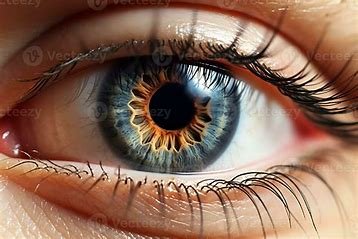The human eye is a complex and highly specialized organ that allows us to see the world around us. It works by converting light into electrical signals that are sent to the brain, where they are interpreted as images.

1. Key Structures of the Human Eye:
- Cornea: The transparent, dome-shaped outer layer of the eye that helps focus light entering the eye. It provides most of the eye’s focusing power.
- Pupil: The circular opening in the center of the iris that controls the amount of light that enters the eye. The pupil dilates (gets larger) in low light and constricts (gets smaller) in bright light.
- Iris: The colored part of the eye surrounding the pupil. It regulates the size of the pupil and controls how much light enters the eye. The iris has muscles that adjust the pupil size in response to light levels.
- Lens: Located behind the iris, the lens focuses light onto the retina. It changes shape to focus on objects at different distances—a process known as accommodation.
- Retina: The light-sensitive layer at the back of the eye that contains photoreceptor cells called rods and cones. Rods are responsible for vision in low light (night vision), while cones detect color and fine detail in bright light.
- Macula: A small, central area in the retina responsible for sharp, central vision. The center of the macula, called the fovea, has the highest concentration of cones and is essential for activities requiring detailed vision, like reading.
- Optic Nerve: The nerve that transmits visual information from the retina to the brain. The point where the optic nerve exits the retina is called the optic disc and does not have any photoreceptor cells, creating a blind spot in the field of vision.
- Sclera: The white, outer protective layer of the eye that maintains its shape and provides a surface for attachment of muscles that control eye movement.
- Vitreous Body: The gel-like substance filling the space between the lens and the retina. It helps maintain the eye’s shape and allows light to pass through to the retina.
- Aqueous Humor: A clear fluid produced by the ciliary body that fills the space between the cornea and the lens. It nourishes the eye and maintains intraocular pressure.
2. How the Eye Works:
- Light enters the eye through the cornea, which bends (refracts) the light to begin the focusing process.
- The light passes through the pupil, which adjusts its size depending on the amount of light.
- The lens further focuses the light onto the retina by changing its shape.
- Photoreceptor cells in the retina (rods and cones) detect the light and convert it into electrical signals.
- The optic nerve carries these electrical signals to the brain, where they are processed into the images we see.
3. Vision Process:
- Accommodation: The eye changes the shape of the lens to focus on objects at different distances.
- Depth Perception: The brain uses the slightly different views from each eye (binocular vision) to perceive depth and distance.
- Color Vision: Cones in the retina are sensitive to different wavelengths of light, allowing us to perceive color. The three types of cones are sensitive to red, green, and blue light.
4. Common Eye Problems:
- Nearsightedness (Myopia): When the eye is too long or the cornea is too curved, causing distant objects to appear blurry.
- Farsightedness (Hyperopia): When the eye is too short or the cornea is too flat, causing close objects to appear blurry.
- Astigmatism: An irregular shape of the cornea or lens causes blurred or distorted vision.
- Presbyopia: Age-related condition where the lens becomes less flexible, making it difficult to focus on close objects.
- Cataracts: Clouding of the lens, leading to blurred vision.
- Glaucoma: A condition where increased pressure in the eye damages the optic nerve, leading to vision loss.
- Macular Degeneration: Age-related damage to the macula of the retina, leading to central vision loss.
- Retinal Detachment: A medical emergency where the retina separates from the back of the eye, potentially leading to blindness if not treated.
5. Protection and Care:
- Blinking: The eyelids help protect the eye from foreign particles and provide moisture.
- Tears: Produced by the lacrimal glands, tears help keep the eye moist and free from dust and bacteria.
- Eyebrows and eyelashes: Protect the eyes from sweat, dust, and other debris.
